 Phil Gordon
.
April 11, 2023
.
Department
Phil Gordon
.
April 11, 2023
.
Department
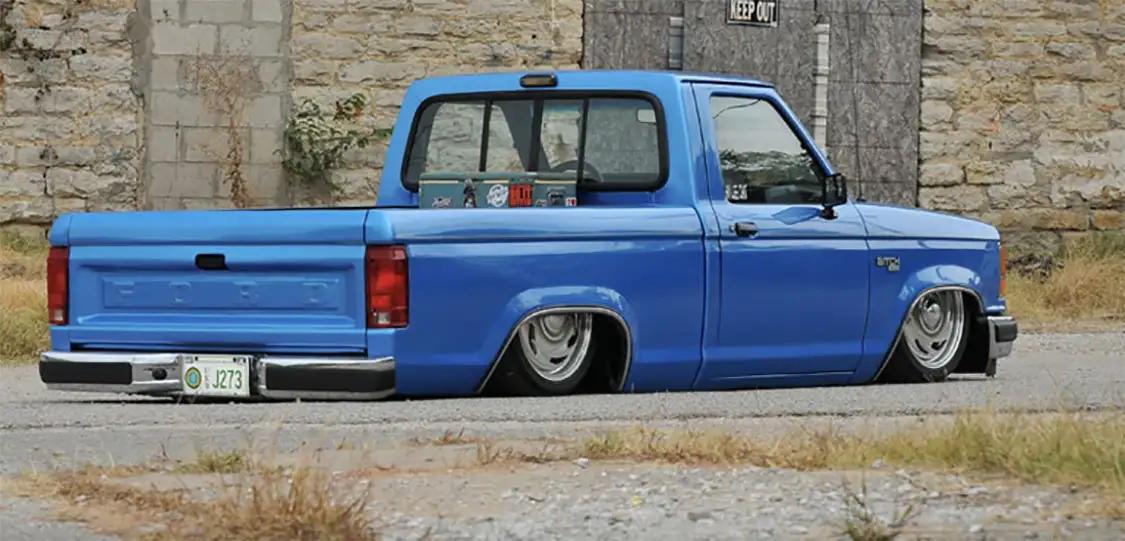
Not every build is a walk in the park. Some build stories have many different components and certain trials and tribulations. Angela Dry from Grove, Oklahoma, is no stranger to adversity. In 2010, she was able to save enough money to buy her truck of choice, an ’85 Ford Ranger. When she finally got the truck home and started to inspect it, she saw the top, bottom of the door frames, and fenders were eaten up by rust. The winter in Oklahoma was likely the cause, with massive snow throughout the entire state in the late months of the year.
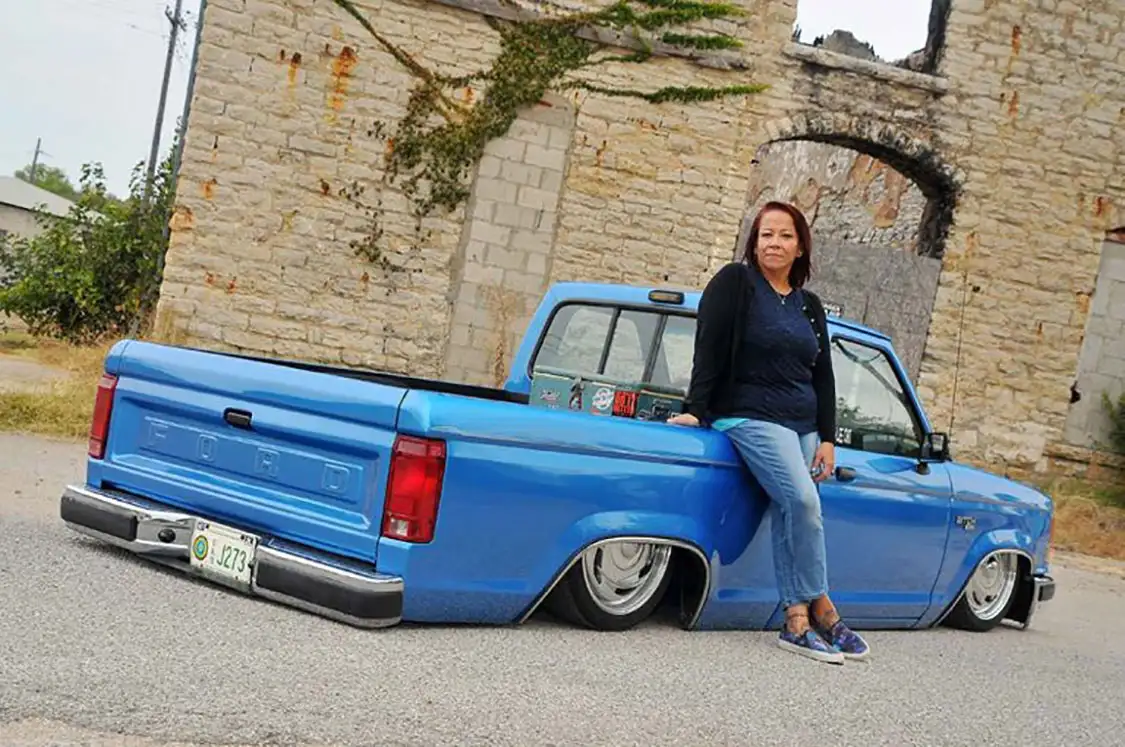
Angela brought the Ranger to a shop and they hacked it up by cutting wires that shouldn’t have been cut.”
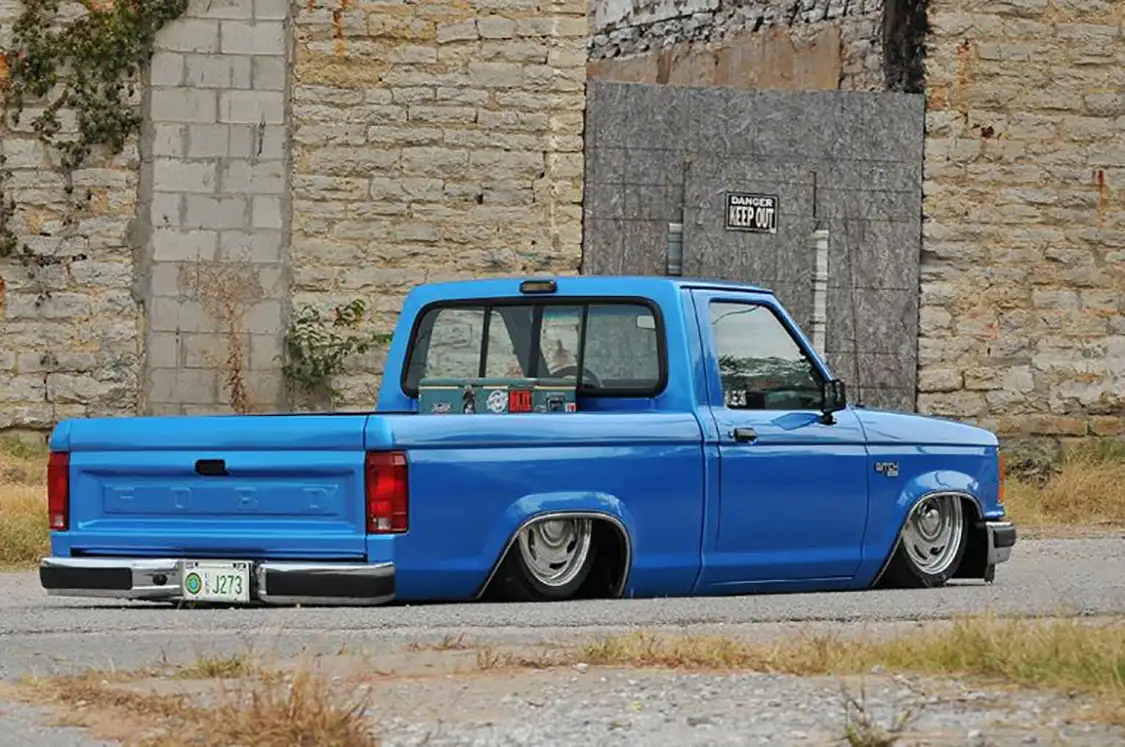
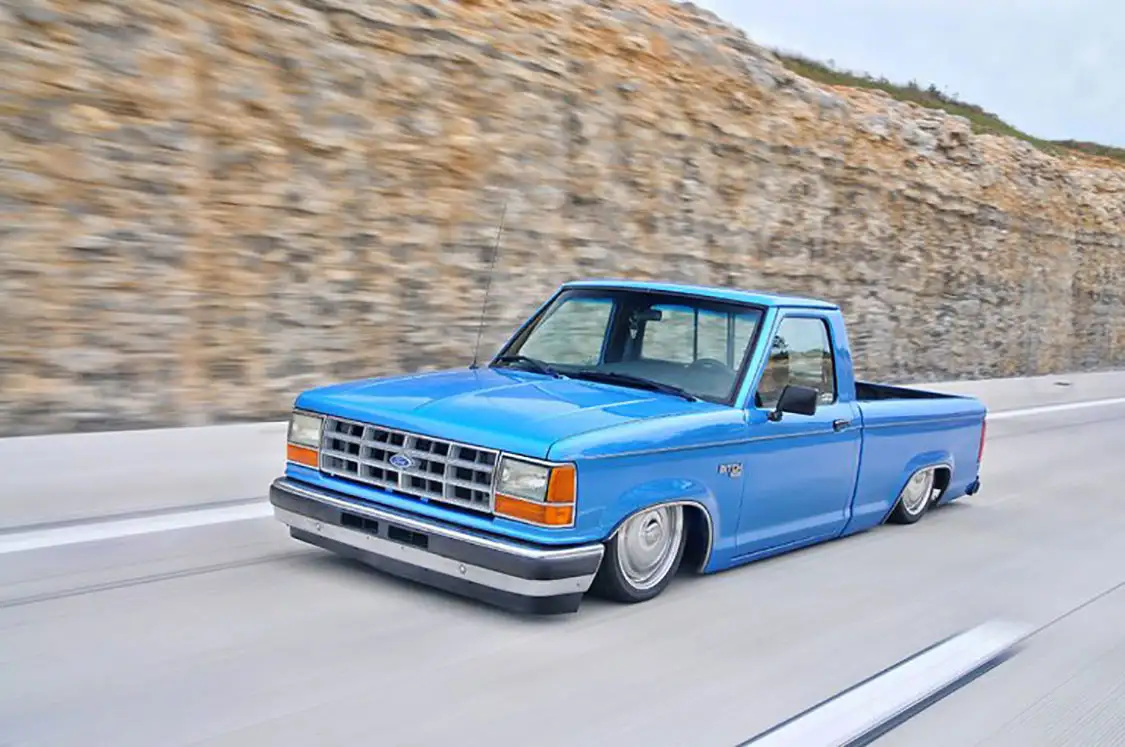
Not wanting to just scrap the entire truck, Angela set out to find a donor truck to combine with her purchase to make one whole truck. The donor truck came from Inola, Oklahoma, and the frame was removed and added to her ’85 Ranger. Angela brought the Ranger to a shop and they hacked it up by cutting wires that shouldn’t have been cut. Angela’s brother Chris Eaton had to go in and rewire everything to correct the issues this fumble caused.
Chris also handled the stock floor body-drop while the transmission had to be modified via a tunnel in the cabin. Once the body was put back on, the bed floor was raised so it wouldn’t have a hole in it. Angela wanted to learn to weld and her brother was more than happy to teach her because it meant less work for him. She spent countless hours spot-welding and working the body and bed floor. He showed her how to patch rust spots, as well as how to shave the gas door. During the process, her brother accidentally put a huge hole in the tailgate, so Angela put her newfound talents to work fixing it on her own. Her repaired tailgate is what’s on the truck today. Chris, Angela, and her long-time boyfriend, Dustin Darby, brought the truck into the paint booth and added a Nissan Pacific Blue paint to the freshly bodied Ranger.
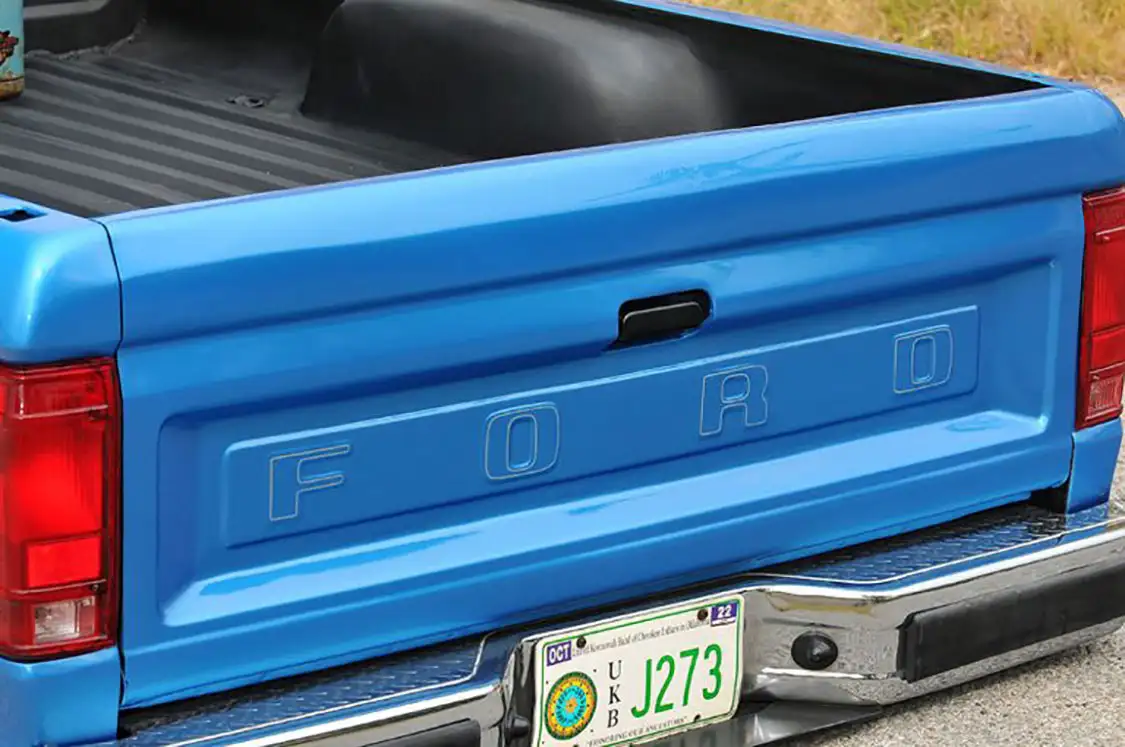
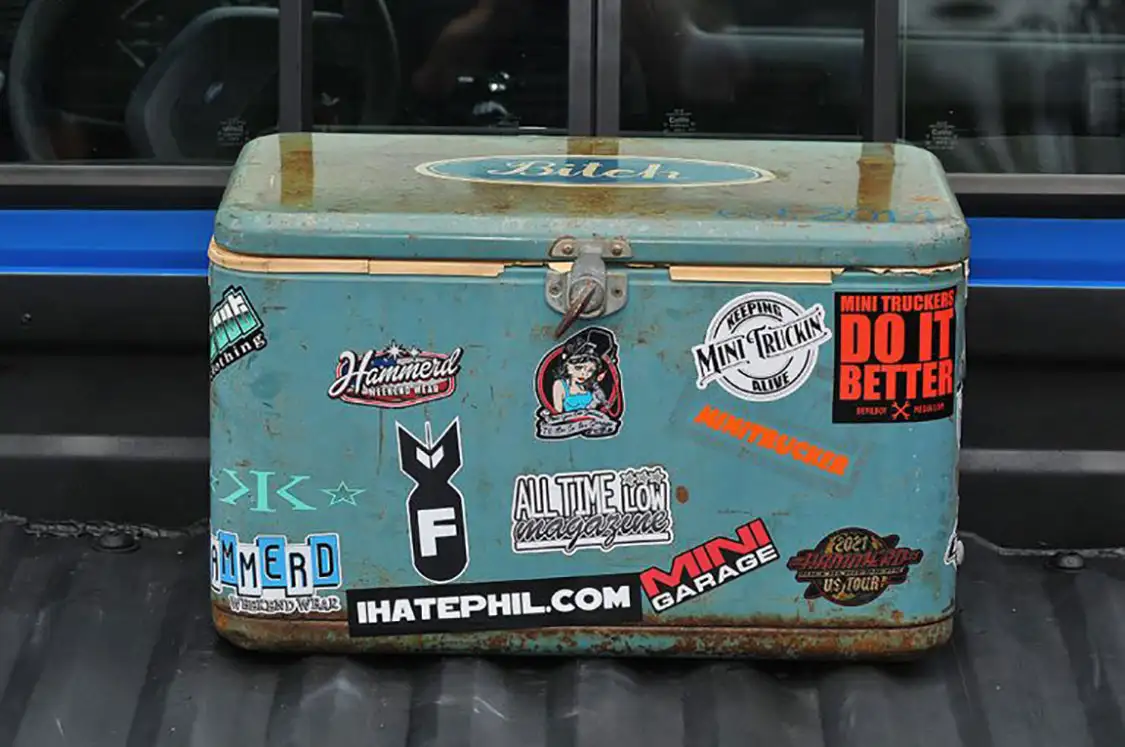
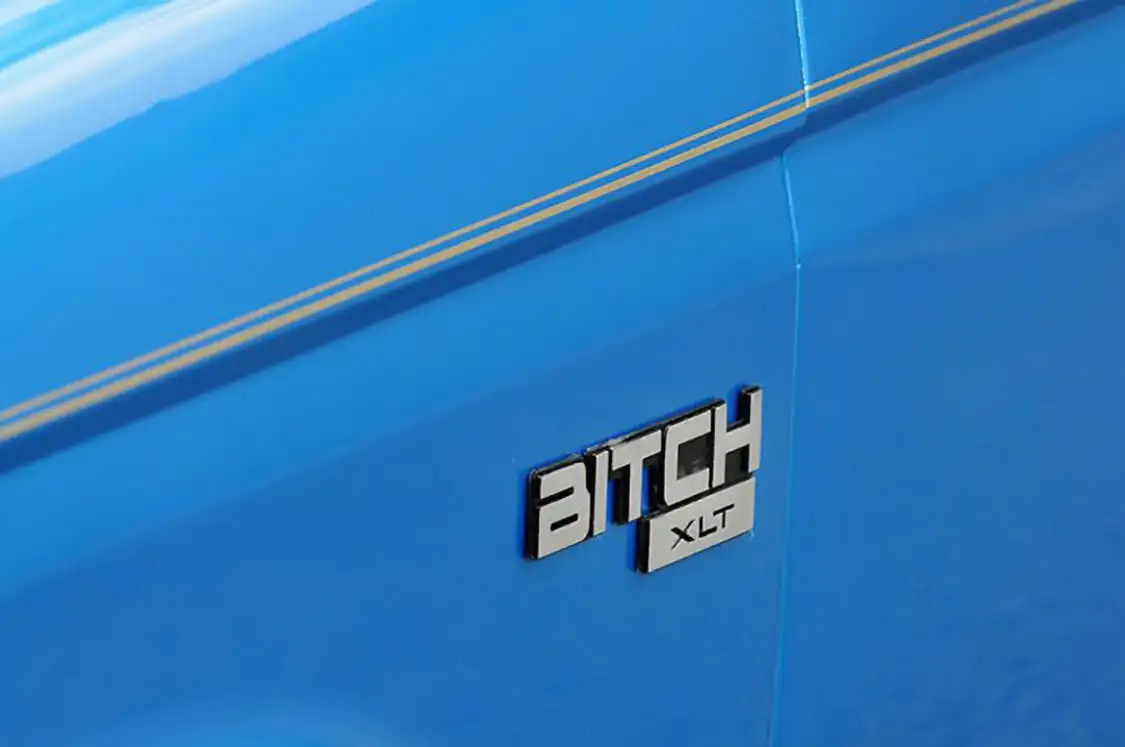
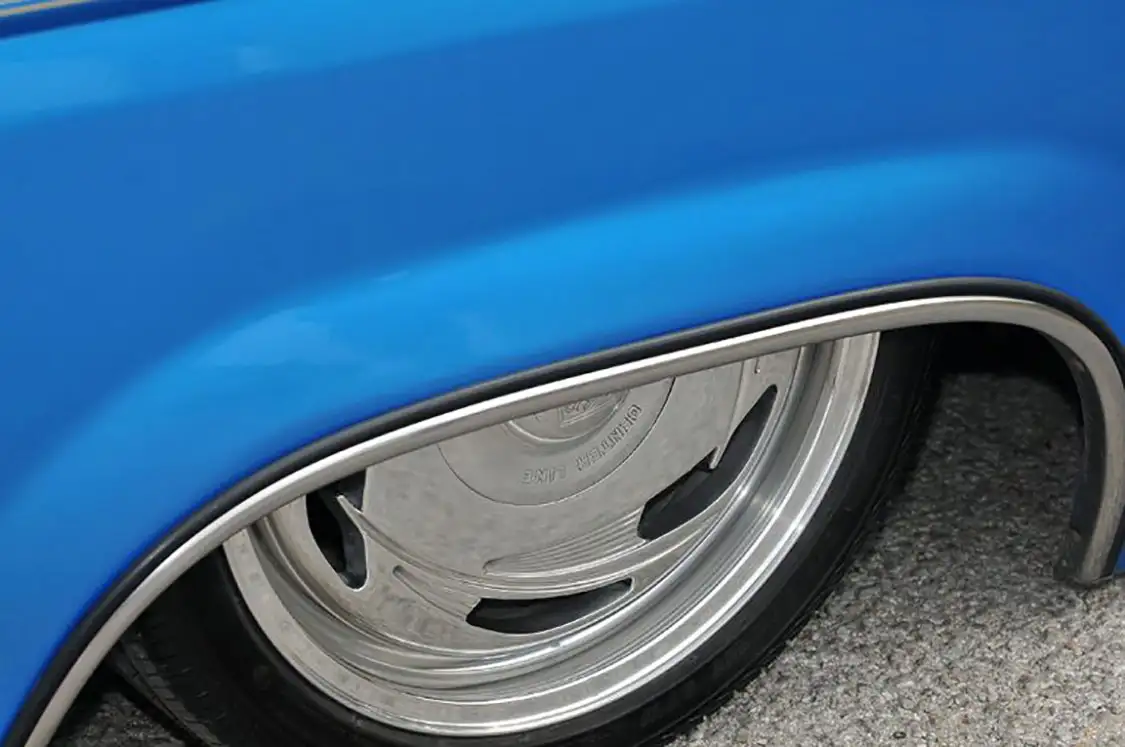
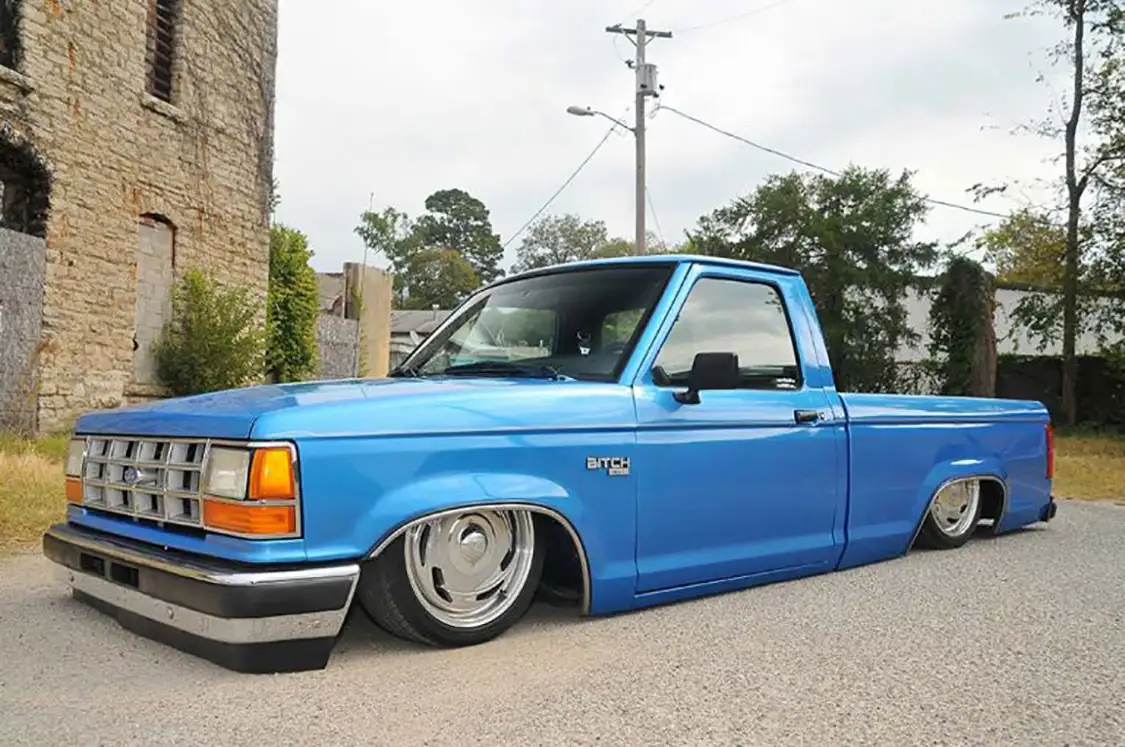
Turning her attention to the interior, Angela located a set of Chevy Cavalier seats and replaced the dilapidated stock seats. The dashboard was restructured due to all the cracks. New carpet was put in and the door panels were replaced. Local upholstery artist, Debra Siske, added new upholstery inside. Angela was able to find a center console that came from a Ford Explorer that fit between the seats to perfection. Her boyfriend, Dustin, works at a glass company, so replacing the glass inside the truck was relatively simple.
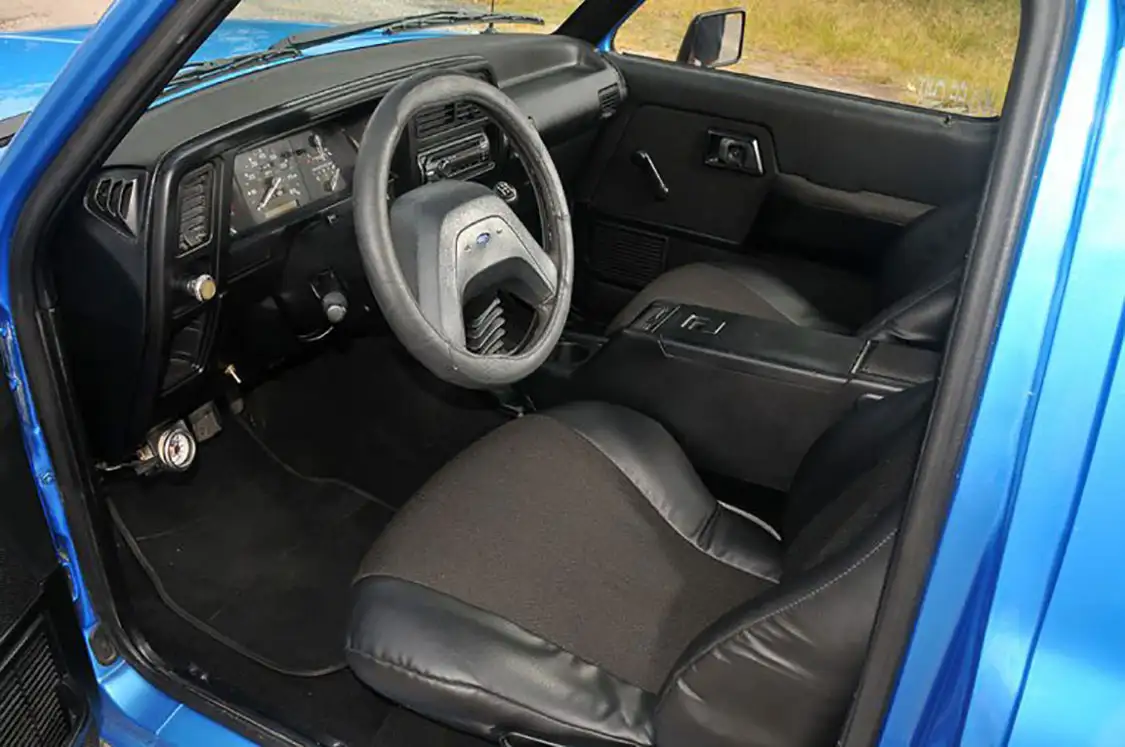
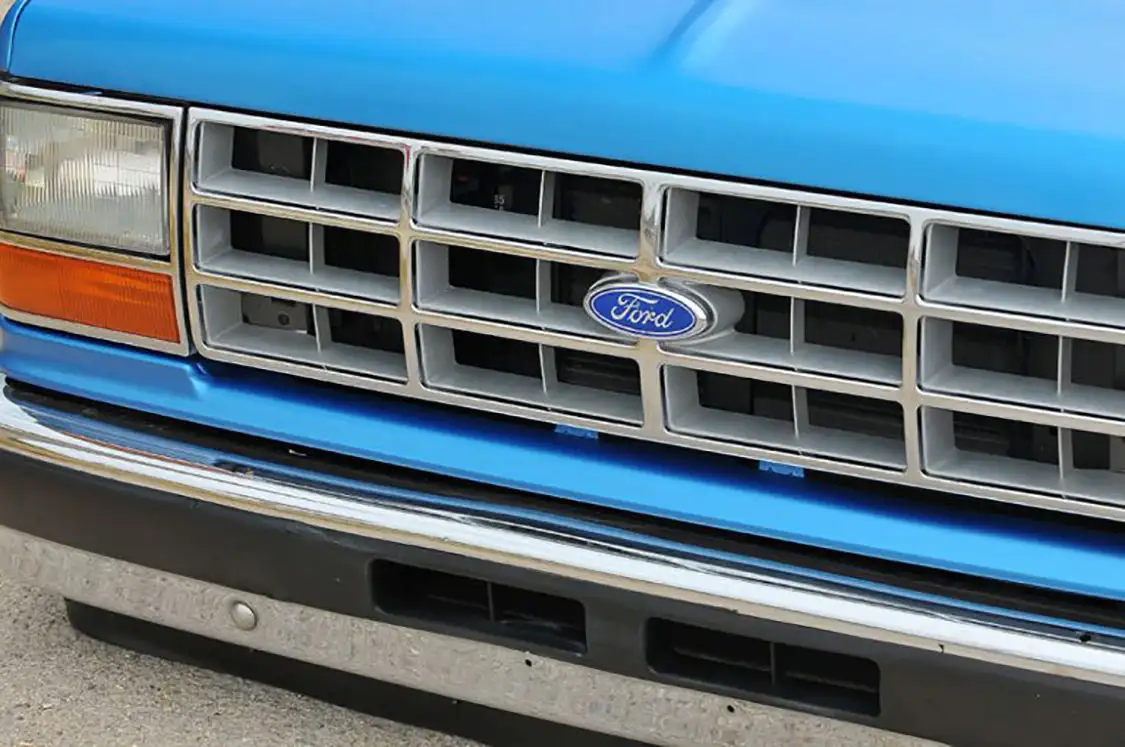

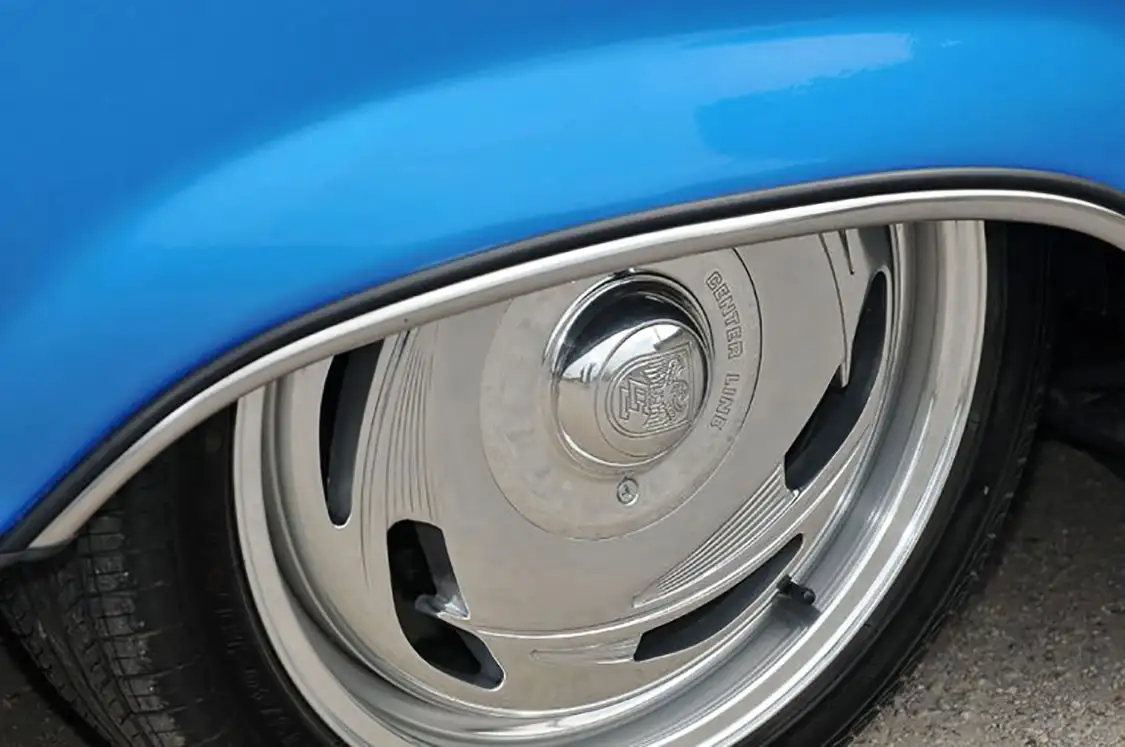
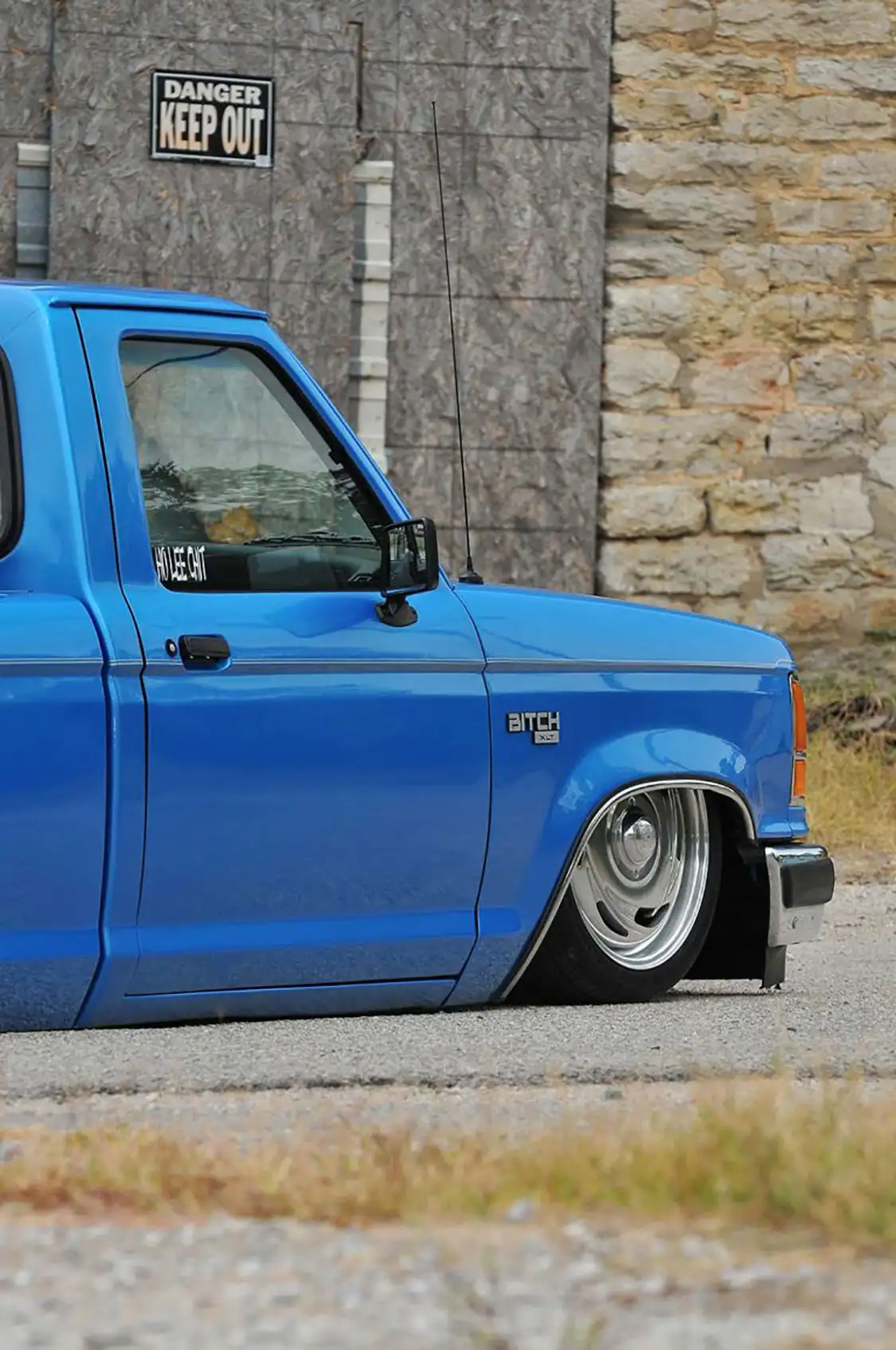
Under the hood, after initially running and driving fine, the stock motor seized on her, adding yet another problem to Angela’s build. Luckily the donor truck’s motor had lower miles and was able to be rebuilt, cleaned, painted, and mounted. Wheel tubs were added for proper fitment, and she decided to go with 17-inch Prime wheels she found in Mississippi to get the Ford rolling on the streets. As it was originally purchased as an ’85 Ford Ranger, the ’92 loaner truck was grafted onto the entire body, so we’ll now call the Ranger a 1992 instead. What made the grafting easy was the fact that the Toyota front clip was used.
Angela wishes to thank her brother for teaching her all the truck and welding skills she now has, her very supportive bearded boyfriend, Dustin Darby, and her two kids, Josie and Joseph, for all their support. As a Cherokee Indian, Angela loves her heritage and has proudly joined the Female Mini-Truckers, with whom she is excited to find camaraderie. With all the bumps in the road she experienced, Angela accurately named her truck The B%#ch.
Angela wanted to learn to weld and her brother was more than happy to teach her because it meant less work for him.”
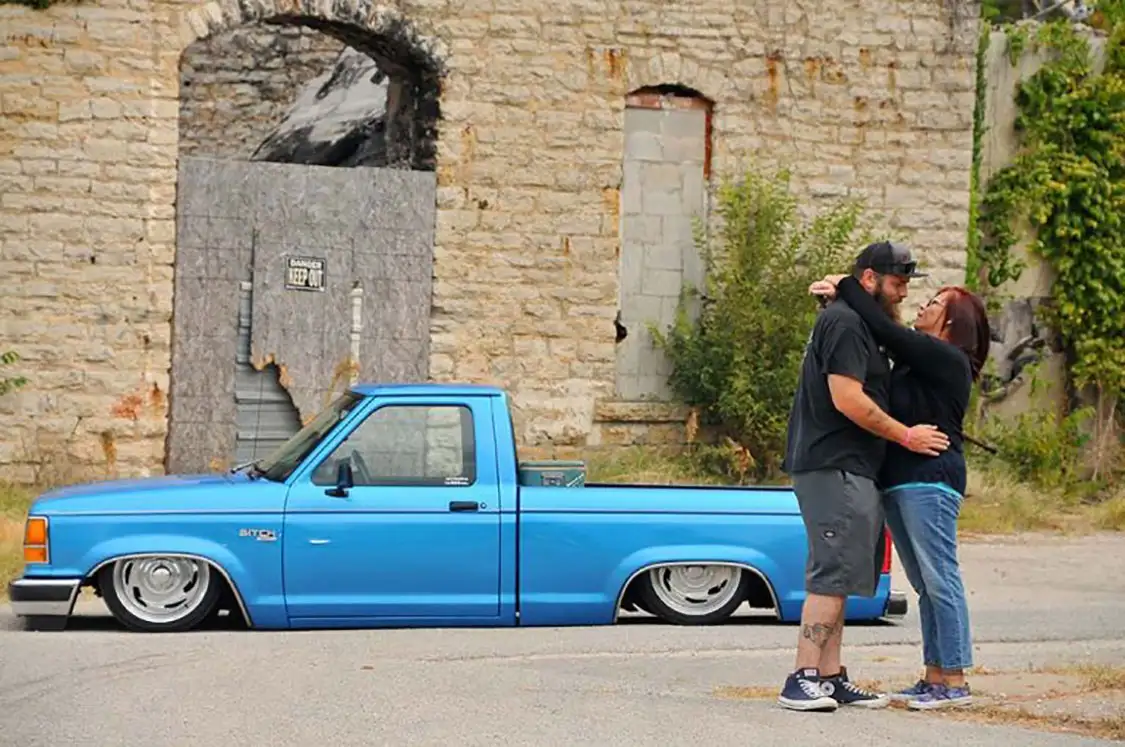
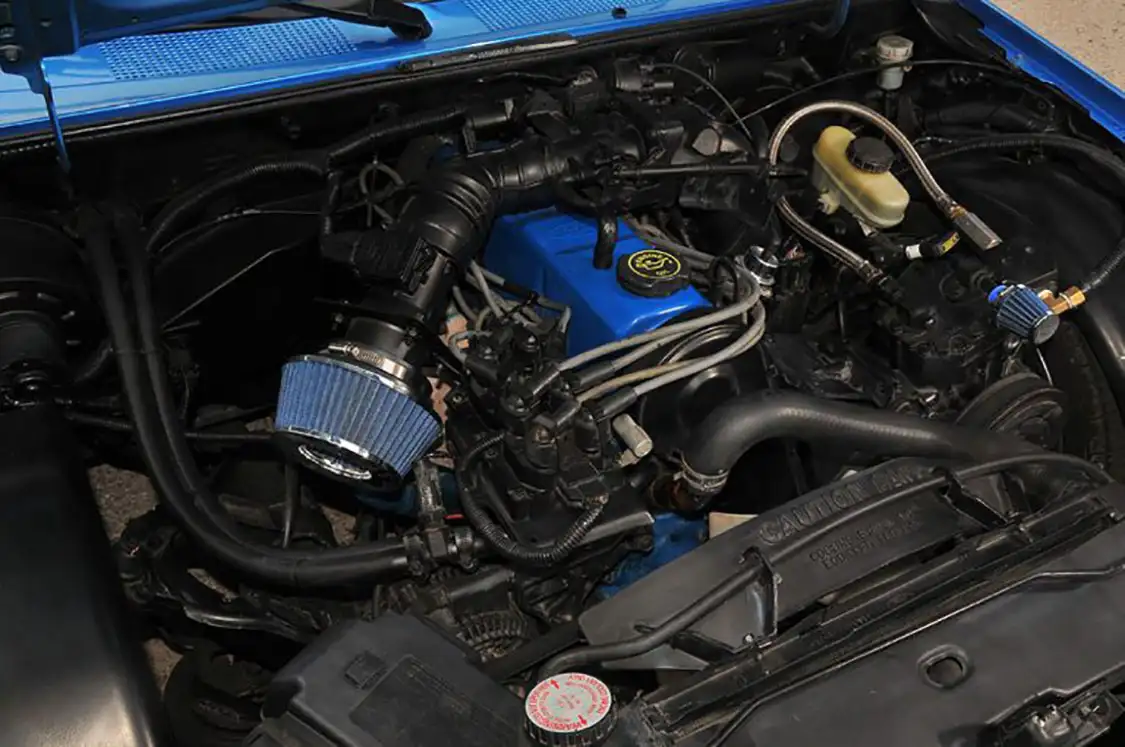
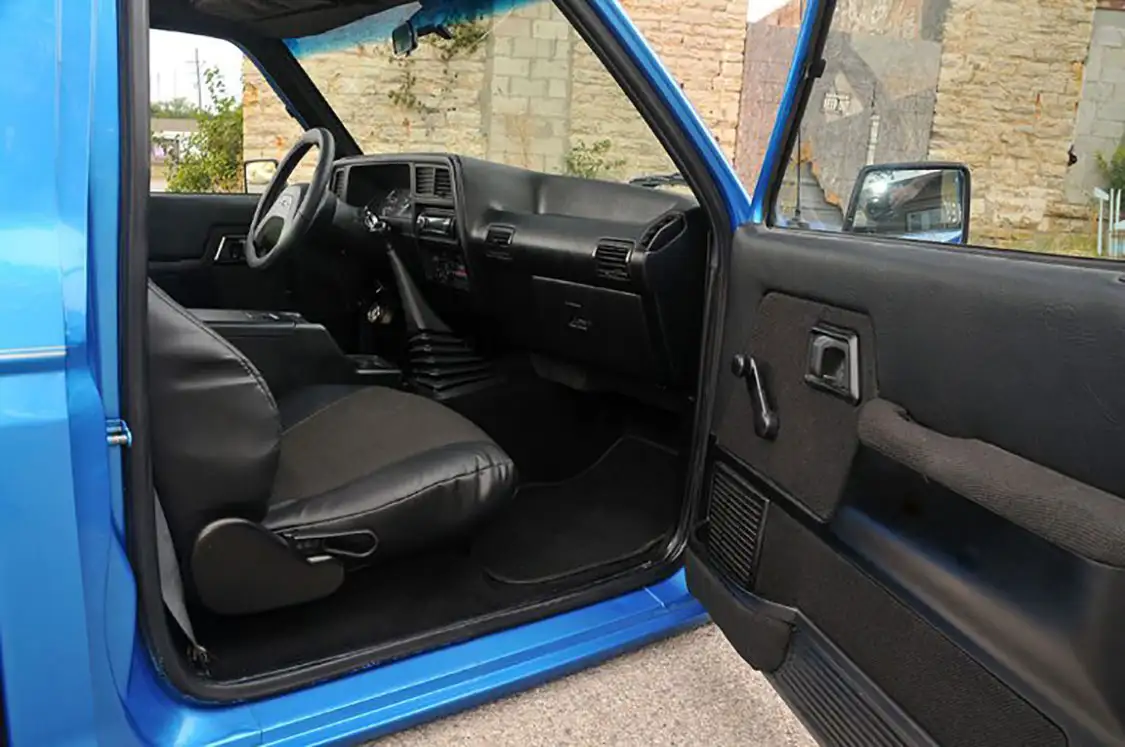
Owner
Angela Dry
1992 Ford Ranger
Grove, Oklahoma
Chassis
Drivetrain
Body/Paint
Interior
Stereo
Wheels & Tires
What Modifications Were Made to Kyle Caso’s 1992 Ford Ranger PreRunner for Racing?
Kyle Caso’s 1992 Ford Ranger PreRunner has undergone significant modifications to transform it from a simple weekend desert runner into a competitive, race-winning machine.
Initially built with basic leaf springs for casual use, the truck has been completely overhauled twice. Here’s a rundown of some key modifications:
The result of these comprehensive upgrades is a formidable race truck that has proven its mettle in various racing series. From competing in the 1450 and 1400 classes to earning podium finishes in prestigious events, Kyle Caso’s Ford Ranger is now a true testament to the power of precision engineering and relentless innovation.
How has Kyle Caso’s Ford Ranger performed in desert racing events?
Kyle Caso’s Ford Ranger has proven itself to be a formidable competitor in desert racing events. Originally a straightforward desert runner, the truck has undergone two significant rebuilds to become a race-winning powerhouse.
Over its racing career, the Ranger has excelled in various classes, specifically the 1450 and 1400 categories. Impressively, it has secured podium finishes across numerous racing series, including MDR, MORE, SCORE, SNORE, Tuff Trucks Challenge, and the Glenn Helen Baja Cup.
This journey highlights not only the truck’s initial purpose as a weekend desert cruiser but also its evolution into a highly competitive race machine. Kyle Caso’s dedication to continuous improvement has clearly paid off, solidifying the Ford Ranger’s reputation in the desert racing community.
What inspired the build of Kyle Caso’s 1992 Ford Ranger PreRunner?
Kyle Caso’s journey into building his 1992 Ford Ranger PreRunner is driven by a deep-rooted passion for off-road racing and an adventurous spirit. Over the years, Kyle has owned several race-inspired prerunners, which essentially laid the groundwork for his fascination with transforming ordinary trucks into high-performance desert machines.
Kyle’s love for the off-road scene saw him frequently attending weekend desert races, where he observed countless high-speed performances and innovative vehicle modifications. These experiences sparked his desire to create his own capable and rugged desert runner.
Starting with a basic leaf-sprung prerunner, Kyle delved into the mechanics and engineering needed to withstand harsh terrains. As he tinkered and tested different setups, his understanding and expertise grew, driving him to pursue more ambitious builds.
Immersing himself in the off-road community allowed Kyle to absorb a wealth of knowledge and inspiration. The camaraderie among enthusiasts and the competitive yet supportive nature of the scene profoundly influenced his approach to vehicle customization.
In summary, Kyle Caso’s 1992 Ford Ranger PreRunner build is a culmination of passion for off-road racing, hands-on learning experiences, and the vibrant culture of the off-road community. With each modification, Kyle moves closer to his vision of the perfect desert machine.
What type of suspension did Kyle Caso’s 1992 Ford Ranger PreRunner originally have?
Kyle Caso’s 1992 Ford Ranger PreRunner originally featured a basic leaf spring suspension. This setup was designed for casual off-road adventures and keeping up with desert racing events.
How many times has Kyle Caso’s 1992 Ford Ranger PreRunner been rebuilt?
Kyle Caso</Kyle Caso>’s 1992 Ford Ranger PreRunner has undergone two complete rebuilds. Thanks to these meticulous overhauls, the vehicle has evolved into a race-winning machine.
What series has Kyle Caso’s 1992 Ford Ranger PreRunner participated in?
Certainly! Here’s a more detailed rewrite:
Kyle Caso’s 1992 Ford Ranger PreRunner has had an impressive racing career, competing across various prestigious series. Notably, it has showcased its capabilities in the 1450 and 1400 classes. The truck has also earned podium finishes in several renowned competitions, including:
These accomplishments highlight the vehicle’s performance and versatility in the off-road racing world.
What are some of the racing achievements of Kyle Caso’s 1992 Ford Ranger PreRunner?
Kyle Caso’s 1992 Ford Ranger PreRunner boasts an impressive résumé in the racing world. Rebuilt twice, this truck has not only withstood the test of time but has also thrived in competitive environments.
Here are the notable milestones:
This storied vehicle continues to build its legacy, proving its mettle in diverse and challenging racing scenarios.
In which racing classes has Kyle Caso’s 1992 Ford Ranger PreRunner competed?
Kyle Caso’s 1992 Ford Ranger PreRunner has made its mark in a variety of racing classes. This vehicle has competed in both the 1450 and 1400 classes, showcasing its versatility and performance. It hasn’t just participated; it’s also excelled, securing podium positions across multiple racing series.
Racing Classes and Achievements:
Podium Finishes in Various Series:
These achievements highlight the truck’s robust rebuilds and exceptional capabilities on the track.
How has Kyle Caso’s 1992 Ford Ranger PreRunner evolved over time?
Kyle Caso’s journey with his 1992 Ford Ranger PreRunner has been nothing short of transformative. Initially, the truck was a straightforward, leaf-sprung build meant for casual weekends in the desert and taking in local races. However, Kyle’s passion for off-road racing soon pushed him to elevate his Ranger far beyond its humble beginnings.
The first significant overhaul saw the Ranger revamped into a more robust prerunner, capable of handling the rigors of competitive racing. This initial rebuild focused on enhancing the suspension and overall durability, making it a formidable contender in off-road events.
Kyle didn’t stop there. The Ranger underwent a second rebuild, this time transforming it into a race-winning machine. The upgrades were comprehensive, featuring advanced suspension systems, improved aerodynamics, and a more powerful engine to ensure it could compete at the highest levels.
With these enhancements, Kyle’s Ford Ranger has not only entered various events but has also consistently landed on the podium. The truck has shown its prowess in numerous prestigious racing series, from the 1450 and 1400 classes to participating in the MDR, MORE, SCORE, SNORE, Tuff Trucks Challenge, and Glenn Helen Baja Cup series.
Kyle Caso’s 1992 Ford Ranger PreRunner has evolved from a simple weekend warrior to a race-dominating machine. Through dedication and strategic upgrades, it has earned respect and accolades in the off-road racing community, demonstrating the profound impact of focused engineering and relentless passion.
What is the history of Kyle Caso’s 1992 Ford Ranger PreRunner?
Kyle Caso’s journey with his 1992 Ford Ranger PreRunner is a tale of evolution and perseverance. Initially, the truck started as a modest, leaf-sprung prerunner, crafted for leisurely weekends in the desert and to keep a finger on the pulse of the racing scene.
However, this truck’s story didn’t stop at being a simple weekend toy. Over the years, Kyle has meticulously rebuilt the Ranger not once, but twice, transforming it into a formidable racing machine. The current iteration is a race-winning vehicle that competes at a high level.
The Ranger has competed in numerous classes, specifically in the 1450 and 1400 categories. It has achieved significant success, repeatedly landing on podiums. Competitions where Kyle’s Ranger has shined include the MDR, MORE, SCORE, SNORE, Tuff Trucks Challenge, and the Glen Helen Baja Cup series.
This evolution underscores not just the vehicle’s transformation, but also Kyle’s dedication and passion for off-road racing.
What is the performance specification, including horsepower and torque, for the 1992 Ford Ranger Regular Cab?
For the 1992 Ford Ranger Regular Cab, the performance specifications are as follows:
These specifications highlight the vehicle’s capability, making it a practical choice for those requiring a reliable and versatile pickup from the early ’90s.
What are the mechanical specifications of the 1992 Ford Ranger Regular Cab?
Mechanical Specifications of the 1992 Ford Ranger Regular Cab
These features highlight the key mechanical aspects of the vehicle, ensuring you get a reliable and hands-on driving experience. The combination of a 2WD drivetrain and a 5-speed manual transmission offers a classic and engaging ride.
What exterior features are available for the 1992 Ford Ranger Regular Cab?
When exploring the exterior options for the 1992 Ford Ranger Regular Cab, you’ll find a range of features designed to enhance both style and functionality. Here’s what you can expect:
The design of the 1992 Ranger reflects a balance between rugged utility and modern styling, offering these options to cater to both practical needs and comfort preferences.
What are the fuel economy ratings for the 1992 Ford Ranger Regular Cab?
When assessing the fuel efficiency of the 1992 Ford Ranger Regular Cab, it’s essential to consider different driving conditions. Here’s a detailed breakdown:
These figures provide a comprehensive overview of what you can anticipate from the 1992 model in terms of fuel consumption, allowing for better planning of journeys and budgeting for fuel expenses.
What are the different trims available for the 1992 Ford Ranger Regular Cab?
If you’re exploring the various trims for the 1992 Ford Ranger with a Regular Cab, there are a few distinctive options worth noting:
These trims cater to different needs, from enhanced cargo capacity to a sportier driving experience.
What are the specifications and features of the 1992 Ford Ranger Regular Cab Custom Short Bed?
The 1992 Regular Cab Custom Short Bed offers a blend of performance, utility, and comfort. Here’s a detailed look at its specifications and features:
These details highlight the truck’s capabilities and comfort features, making it a reliable choice for those seeking a compact and versatile vehicle.
How does the 1992 Ford Ranger Regular Cab compare to similar vehicles in terms of price and features?
When evaluating a pre-owned 1992 Ford Ranger Regular Cab against other comparable vehicles from the same era, it’s crucial to explore various aspects such as price, consumer ratings, fuel efficiency, and features.
The 1992 Ford Ranger Regular Cab is competitively priced at $1,964. This places it in a similar range as its counterparts, with prices like:
Customer satisfaction is a strong point for the Ford Ranger, boasting a rating of 4.3 out of 5. This is comparable to:
In terms of fuel efficiency, the Ford Ranger yields a respectable City 20 / Hwy 26 / Comb 22 MPG, aligning it closely with:
All vehicles operate on gasoline, providing consistent fuel type options across the board.
Each vehicle can accommodate a seating capacity of 3 and offers a basic warranty of 3 years or 36,000 miles for the Ford Ranger, similar to the Chevrolet, with the Isuzu and Mazda offering slightly extended coverage up to 50,000 miles.
The Ford Ranger features a 4-cylinder, 2.3-liter engine, delivering 100 horsepower at 4600 RPM. This is contrasted by:
All models are equipped with 2WD drivetrain, maintaining consistency in traction and handling across these selections.
In summary, the 1992 Ford Ranger Regular Cab stands as a well-rounded choice when considering pricing, consumer approval, fuel economy, and features, holding its ground effectively against other similar vehicles from the era.
What are the standard features of the 1992 Ford Ranger Regular Cab Custom Short Bed?
Are you curious about what makes the 1992 Ford Ranger Regular Cab Custom Short Bed stand out? Here’s a breakdown of its notable features that are offered as standard:
These combined elements create a well-rounded vehicle that blends comfort, style, and functionality, catering to a variety of driving needs.
What are the dimensions, weights, and capacities of the 1992 Ford Ranger Regular Cab?
For those looking to understand the full specifications of the 1992 Ford Ranger Regular Cab, here’s a breakdown of its dimensions, weights, and capacities:
These specifications highlight the versatile nature of the 1992 Ford Ranger Regular Cab, making it a reliable choice for those in need of both capacity and capability. Whether it’s for work or daily commutes, this vehicle meets diverse requirements with ease.
What factors influence the depreciation of a 1992 Ford Ranger Regular Cab Custom Short Bed?
When determining how much a 1992 Ford Ranger Regular Cab Custom Short Bed might depreciate, several factors come into play, both predictable and variable.
Understanding these factors helps in predicting how a vehicle like the 1992 Ford Ranger might depreciate over time, without guarantees, of course. Each element, from the specific condition to broader economic patterns, interplays to determine its eventual market value.
What is the price range for used Ford Ranger models from different years?
If you’re in the market for a used Ford Ranger, there’s a wide array of options spanning different model years and prices. Here’s a look at the range you can expect:
Whether you’re after a budget-friendly Ranger or a high-end model with premium features, there are choices to suit various preferences. Investigate the vehicle’s condition and historical background for a sound investment.
What are the estimated resale and trade-in values for a 1992 Ford Ranger Regular Cab Custom Short Bed?
If you’re wondering about the estimated resale and trade-in values for a 1992 Ford Ranger Regular Cab Custom Short Bed, here’s the breakdown:
It’s also worth noting that in the past three years, this particular model has seen a depreciation of $274. Keep these figures in mind when evaluating your transaction options.
What warranty options are available for the 1992 Ford Ranger Regular Cab?
When considering the purchase of a 1992 Ford Ranger Regular Cab, it’s important to understand the warranty coverage you can expect. Here’s a detailed breakdown of the warranty options available:
These warranties are designed to offer a balance of protection and reliability for the 1992 Ford Ranger Regular Cab. Always check with the dealer or consult the vehicle’s manual for the most accurate and detailed information.
How has the 1992 Ford Ranger Regular Cab Custom Short Bed depreciated over time?
Understanding how the 1992 Ford Ranger Regular Cab Custom Short Bed depreciates involves looking at both past trends and future forecasts. Depreciation gives you an idea of how the value of your vehicle decreases as time goes by.
The vehicle’s value over the next two years can be estimated by examining both past performance and auction data. However, it’s important to note that these are projections and not guarantees. Factors like weather, market trends, and individual driving habits can significantly impact these figures.
Depreciation is calculated by examining vehicles of similar make and age. By comparing auction prices to market values, one can attempt to predict how much the vehicle’s value might decline in the coming years. However, keep in mind that actual depreciation will vary based on several external conditions.
In essence, while general trends can help you anticipate changes in your vehicle’s worth, remember that many variables play a role in actual depreciation.
How much does it typically cost to bag a Ford Ranger?
Bagging a Ford Ranger involves replacing the vehicle’s suspension with air bags to allow for adjustable ride height and improved performance. Here’s a detailed breakdown of associated costs:
Remember, these estimates can vary widely based on the specific parts chosen and the level of customization desired. It’s wise to allow for a buffer in your budget to accommodate unexpected expenses.
How does the choice between a 2-way or 4-way air suspension system affect the bagging process?
When deciding between a 2-way and a 4-way air suspension system for the bagging process, each option has unique implications for the overall project and outcome.
Ultimately, choosing between a 2-way or 4-way air suspension system impacts the complexity, control, cost, and potential need for vehicle modification. A 4-way system enhances precision and flexibility but at the expense of higher complexity and cost, making it ideal for those who prioritize enhanced performance and handling in their vehicle customization projects.
Is it safe to drive a vehicle with a significant drop, such as a 5/6 drop?
Lowering a vehicle, such as implementing a 5/6 drop, can certainly enhance its visual appeal and improve handling. However, safety is a key concern for many drivers considering such modifications.
When done correctly, lowering a vehicle with a 5/6 drop can be safe. Choose quality parts, maintain adequate suspension, and be aware of the trade-offs in comfort and ground clearance. By taking these precautions, you can enjoy a stylish and well-handling vehicle without compromising safety.
Should the front or rear of a vehicle be bagged first?
When deciding whether to bag the front or rear of a vehicle first, it ultimately boils down to personal preference and the complexity of the task. Both ends offer their own challenges and simplicity. However, considering some logical steps can make the decision easier.
By starting with what might be perceived as the more difficult end, you can relieve the pressure for the remainder of the project, knowing the hardest part is behind you.
Ultimately, the decision should be based on your own workflow preferences and how you manage complex tasks. If getting the tough stuff out of the way aligns with your style, start with the rear. If you’d rather see faster progress initially, go with the front.
Consider your experience, available tools, and the vehicle’s design to choose the path that best suits your comfort and skill level.
What are the potential challenges or considerations when bagging a vehicle with neons?
Bagging a vehicle involves modifying the suspension system by installing air suspension, which can offer improved ride quality and adjustable ride heights. However, when a vehicle is also equipped with neon lighting, there are several considerations and potential challenges to keep in mind:
In summary, while bagging a vehicle can dramatically enhance its performance and style, it requires careful planning—especially when additional elements like neon lighting are involved. Prioritize safety, functionality, and cost-efficiency for the most successful and satisfying modification.
What resources or contacts are available for assistance with bagging a vehicle in Indiana?
If you’re in Indiana and looking to “bag” your vehicle, there are several resources you can explore for assistance:
By combining these resources—personal contacts, local shops, and parts suppliers—you’ll be well-equipped to find the assistance you need for bagging your vehicle in Indiana.
What is the general process for bagging a Ford Ranger?
Chris also handled the stock floor body-drop while the transmission had to be modified via a tunnel in the cabin. Once the body was put back on, the bed floor was raised so it wouldn’t have a hole in it. Angela wanted to learn to weld and her brother was more than happy to teach her because it meant less work for him. She spent countless hours spot-welding and working the body and bed floor. He showed her how to patch rust spots, as well as how to shave the gas door. During the process, her brother accidentally put a huge hole in the tailgate, so Angela put her newfound talents to work fixing it on her own. Her repaired tailgate is what’s on the truck today. Chris, Angela, and her long-time boyfriend, Dustin Darby, brought the truck into the paint booth and added a Nissan Pacific Blue paint to the freshly bodied Ranger.
What modifications are necessary for wheels and tires when bagging a Ford Ranger?
Under the hood, after initially running and driving fine, the stock motor seized on her, adding yet another problem to Angela’s build. Luckily, the donor truck’s motor had lower miles and was able to be rebuilt, cleaned, painted, and mounted. Wheel tubs were added for proper fitment, and she decided to go with 17-inch Prime wheels she found in Mississippi to get the Ford rolling on the streets. As it was originally purchased as an ’85 Ford Ranger, the ’92 loaner truck was grafted onto the entire body, so we’ll now call the Ranger a 1992 instead. What made the grafting easy was the fact that the Toyota front clip was used.
Bagging the Ranger came with its own set of challenges. First, expect to spend at least $1,200 in parts to get the suspension ready for the transformation. If you’re new to welding or have never tackled suspension work, it’s wise to consult a professional. For those considering bagging only one end, starting with the front is often recommended due to its impact on vehicle handling and aesthetics.
When it comes to the wheels, Angela ensured they would fit perfectly by adding wheel tubs. It’s crucial to remove the interior fenders for clearance, allowing the wheels to sit just right under the body. These modifications not only gave Angela’s Ranger a sleek, grounded look but also maintained the functionality she desired.
By blending these technical adjustments with her vision, Angela transformed the Ranger into a head-turning street machine, seamlessly merging practicality with style.
What specific changes need to be made to accommodate the wheels when bagging a Ford Ranger?
The interior fenders need to be removed to ensure the wheels fit properly during the bagging process.
If only one end of the truck is to be bagged, which end should be done first?
Priority should be given to bagging the front end of the truck first.
What skills are necessary to perform the bagging modification?
Skills in welding and suspension work are crucial for successfully completing the bagging modification.
What is the estimated cost of parts needed for bagging a Ford Ranger?
You should expect to spend at least $1,200 on parts for bagging a Ford Ranger.
What are the necessary components for bagging a vehicle?
Front Suspension: Slam Specialties 2,600-pound air bags, Thorbeck Brothers upper and lower control arms.
To fully bag a vehicle, you’ll need more than just the suspension components. Here’s a breakdown of what you should consider:
Together, these components create a system that not only enhances your vehicle’s performance but also its aesthetic appeal.
Is there a cost consideration for these components?
Yes, the cost of these components can add up significantly, highlighting the financial investment required for a complete air suspension setup.
What additional components might be needed beyond the suspension itself?
Beyond the core suspension parts, you’ll also require items like notches and shocks to ensure the system integrates well with your vehicle and functions correctly.
What are the basic components needed for an air suspension system?
To set up an air suspension system, you’ll need components such as a four-link setup, air bags, air lines, a compressor, valves, and tanks.
Is it necessary to cut the bed for axle clearance during the bagging process?
When approaching the bagging process, it’s essential to consider whether modifications like cutting the bed are necessary for axle clearance. Depending on your setup, such as opting for a 2-way (FB) or a 4-way (FBSS) system, the requirements can vary.
In some cases, cutting the bed for axle clearance is unavoidable to ensure smooth operation and prevent any interference. Consulting with a professional who can evaluate your specific setup and make the necessary adjustments, such as adding wheel tubs, can make all the difference. This not only improves fitment but also enhances the overall performance and appearance of your vehicle.
Will the rear bed be modified for axle clearance during the installation?
There is a consideration for cutting the bed to ensure adequate axle clearance.
What type of suspension setup are you using: a 2-way system or a 4-way system?
The setup involves deciding between a 2-way (FB) or a 4-way (FBSS) suspension system.
Can the bagging process be done by oneself, and how difficult is it?
Angela wanted to learn to weld and her brother was more than happy to teach her because it meant less work for him. She was eager to dive into projects, but when it came to bagging a truck, she realized the need for caution. Her brother explained, “If you’ve never done this kind of work before, it might be worth considering hiring a professional.”
He shared his own experience, “I can weld, but I’ve never tackled suspension work myself. It’s a whole different beast.” Angela appreciated his honesty, understanding that suspension work involves more than just welding skills. The complexity of installing air suspension, or “bagging,” requires careful attention, especially the rear, which demands more effort.
Angela’s brother advised her to tackle the front part first if she wanted to try, as it was less daunting—mostly involving welding in the bag cups and connecting the airline. But he emphasized that the rear might be best left to someone with experience.
For Angela, learning to weld was a step toward independence, but she also recognized the wisdom in knowing when to seek help, ensuring her projects were not just done, but done right.
How far is a recommended professional service from the reader’s location?
A recommended service provider is approximately 200 miles away, offering a feasible option for those willing to travel for expert assistance.
What skills are necessary to complete the bagging process?
Proficiency in welding and experience in suspension work are crucial for undertaking the bagging process effectively.
What is the relative difficulty of working on different parts of the truck’s suspension (front vs. Rear)?
The rear suspension generally requires more work and is more challenging compared to the front, which involves simpler tasks such as welding bag cups and connecting airlines.
Where can one find professional help or advice for bagging a truck?
Consider contacting a specialized service like Suicide Doors in Francisco, IN, and speak with a knowledgeable contact, possibly someone recommended by others who have had similar work done.
Should a beginner attempt the bagging process alone?
It’s advisable for beginners to seek professional help if they lack welding or suspension experience, as attempting it alone could be challenging.
Are larger rims compatible with a bagged vehicle, and what modifications might be necessary?
Under the hood, after initially running and driving fine, the stock motor seized on her, adding yet another problem to Angela’s build. Luckily, the donor truck’s motor had lower miles and was able to be rebuilt, cleaned, painted, and mounted. Wheel tubs were added for proper fitment, and she decided to go with 17-inch Prime wheels she found in Mississippi to get the Ford rolling on the streets. As it was originally purchased as an ’85 Ford Ranger, the ’92 loaner truck was grafted onto the entire body, so we’ll now call the Ranger a 1992 instead. What made the grafting easy was the fact that the Toyota front clip was used.
When it comes to choosing rims for a bagged vehicle, size matters more than you might think. Angela considered going beyond the 17-inch wheels but was cautious about the potential complications. If you decide to opt for rims larger than 18 inches, be prepared for some significant modifications:
These considerations highlight why Angela opted for the 17-inch wheels, balancing style with practicality. This strategic choice allowed her build to maintain both its sleek appearance and functional integrity, ensuring her truck was ready to hit the streets without unnecessary complications.
What specific modifications are needed for larger rims on a bagged vehicle?
To accommodate rims over 18 inches, you may need to reposition engine components and modify the fenders in the bed to ensure the truck lays evenly.
What rim size might require additional modifications?
Rims larger than 18 inches may necessitate further adjustments to the vehicle.
What considerations should be made regarding welding skills and suspension work experience?
Angela wanted to learn to weld, and her brother was more than happy to teach her because it meant less work for him. She spent countless hours spot-welding and working the body and bed floor. He showed her how to patch rust spots, as well as how to shave the gas door. During the process, her brother accidentally put a huge hole in the tailgate, so Angela put her newfound talents to work fixing it on her own. Her repaired tailgate is what’s on the truck today. Chris also handled the stock floor body-drop while the transmission had to be modified via a tunnel in the cabin. Once the body was put back on, the bed floor was raised so it wouldn’t have a hole in it.
Before embarking on a similar journey, consider the following:
Angela’s story illustrates the value of learning and gaining experience, but it also serves as a reminder that not everyone will have a skilled mentor at their disposal. Assess your skills honestly and consider professional help if needed to avoid costly mistakes.
What are the risks or recommendations for someone lacking these skills?
If you lack experience in welding or suspension work, it’s advisable not to undertake this project on your own due to potential risks and complications.
What level of welding and suspension work experience is needed?
It’s crucial to have a solid understanding of welding and suspension work before attempting this project yourself.
What financial investment is required for parts when undertaking this kind of work?
You should anticipate spending at least $1,200 on parts alone for this type of project.
Share Link